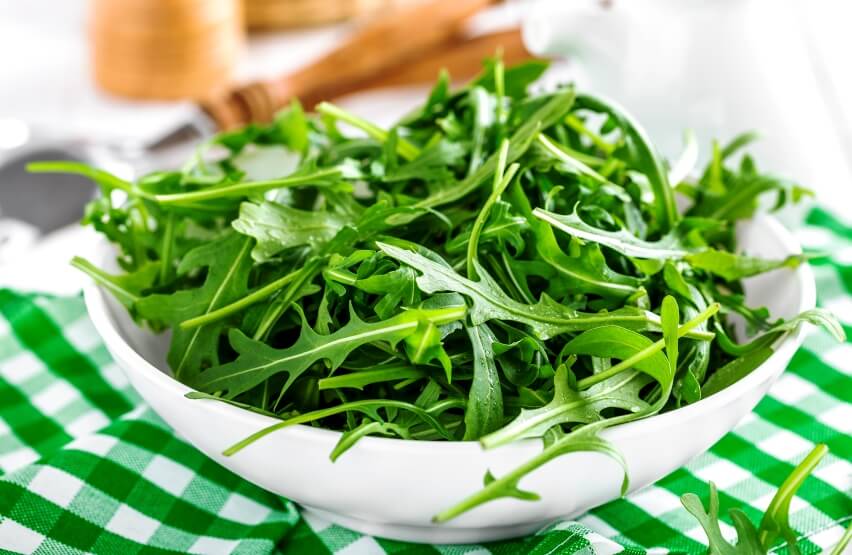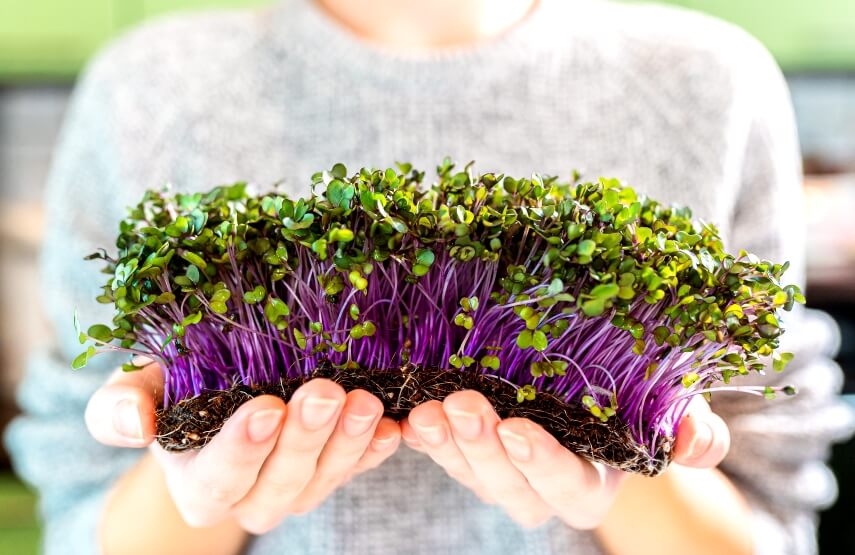One of the key benefits of growing your own microgreens is that it only takes a few weeks to grow your own food. Among different microgreens some of them grow faster and are easier to grow indoors. This article will list top easiest and fastest microgreens to grow indoors.
If Like to know more about microgreens, check these articles:
<<What Are Microgreens >> and <<How Much Microgreens To Eat Per Day>>
Top easiest and fastest microgreens
| Microgreen name | Average days to germinate | Average days to harvest (after sowing) |
|---|---|---|
| Cress | 2-3 days | 9-12 days |
| Radish | 2-3 days | 9-12 days |
| Arugula | 2-3 days | 8-10 days |
| Kale | 2-3 days | 9-12 days |
| Broccoli | 3-4 days | 9-11 days |
| Red cabbage | 3-5 days | 8-11 days |
| Pea | 3-5 days | 9-11 days |
| Clover | 2-3 days | 10-12 days |
| Alfalfa | 2-3 days | 10-12 days |
| Wheatgrass | 2-3 days | 10-12 days |
| Mustard | 3-4 days | 10-14 days |
| Lettuce | 2-3 days | 12-16 days |
| Corn | 3-5 days | 11-13 days |
| Beetroot | 4-6 days | 12-15 days |
Cress microgreens
Cress microgreen is one the easiest and fastest microgreens to grow indoors. Garden cress microgreen germinates in 2 to 3 days and can be harvested 8 to 10 days after germination. It has a tangy flavor and a pleasing bite, and its tiny, soft leaves grow on a white stem.
Garden cress microgreen is excellent in salad dressings and gives a unique touch to wraps and sandwiches. Although keeping it looking fresh and vivid when stored can be difficult, it is a beautiful addition to the home grower’s pallet.
Radish microgreens
Radish microgreen is the second candidate on the list of the fastest and easiest microgreen to grow indoors. Radish microgreen germinates in 2 to 4 days and can be harvested 6 to 8 days after germination.
Consuming radish microgreens is a fantastic way to boost your diet’s nutritional value and flavor. Along with Iron, Calcium, manganese, phosphorous, magnesium, and zinc, radishes are a great source of vitamins A, B, C, E, and K. Additionally. They are rich in antioxidants, which might aid the body fight inflammation.
Arugula microgreens
The arugula microgreen is the third contender on the list of the easiest and fastest microgreens to grow indoors. Arugula microgreen germinates in 2 to 3 days and can be harvested 5 to 7 days after germination.
Arugula, sometimes known as rocket or roquette, is one of the most popular microgreens. Its spicy flavor and lovely heart-shaped leaf make it an excellent addition to larger salad combinations. Fast germination and rapid growth make it easy for almost anyone to grow arugula microgreens.
Broccoli microgreens
Broccoli microgreens are among the most straightforward and fastest-growing micro plants. Broccoli microgreens do not require much care and usually germinate in 2 to 3 days. They are often ready to harvest within 10 days of planting.
Broccoli greens are excellent, although there is some disagreement about the flavor. Some believe immature shoots taste like mature broccoli, while others think they taste more like cabbage. In any case, growing and eating this microgreen is a delightful experience.
Red cabbage microgreens
The fifth contender on the list of the fastest and easiest microgreen to grow indoors is the red cabbage microgreen. Red cabbage microgreen germinates in 3 to 5 days and can be harvested 4 to 7 days after germination.
The mild cabbage flavor of cabbage microgreens makes them the ideal base for any mix. Due to dark purple leaves with red veins and dark red stems, red cabbage is the most popular cultivar grown as microgreens. Cabbage microgreens taste great in salads when combined with relatives like broccoli and kale.
Pea microgreens
Pea microgreen is the sixth candidate on the list of the easiest and fastest microgreens to grow indoors. Pea microgreen germinates in 2 to 3 days and can be harvested 5 to 7 days after germination.
Peas are one of the most popular microgreens for chefs and families, as they are simple to grow and add a vibrant, crunchy taste of spring to any salad.
Pea microgreens, like snow peas, have a similar flavor to full-grown peas and are recognized for being sweet. They are high in anti-inflammatory vitamins that help to improve cardiovascular health. Weight reduction has also been linked to pea microgreens, owing to their high fiber content.
Kale microgreens
Kale microgreen is the seventh candidate on the list of the easiest and fastest microgreens to grow indoors. Kale microgreen germinates in 2 to 3 days and can be harvested 6 to 9 days after germination.
One of the most nutrient-dense superfoods on the planet is kale microgreen! They are low in calories and offer several health advantages. Kale microgreens contain four times as much nutrition as the full-grown form of kale.
Kale is renowned for its numerous health advantages and beneficial nutrients. Along with minerals, fiber, antioxidants, potassium, calcium, magnesium, copper, and manganese, it also has vitamins A, C, K1, and B6.
Clover microgreens
The eighth contender on the list of the fastest and easiest microgreen to grow indoors is the clover microgreen. Clover microgreen germinates in 2 to 3 days and can be harvested 8 to 9 days after germination.
Clover plant is appealing to both humans and animals because of its crisp texture and nutty flavor. Clover microgreens are gorgeous pale green and have a light, delicious flavor. Micro clovers have plump, crisp cotyledons and are remarkably similar to alfalfa microgreens. They grow rapidly and are harvest-ready in less than ten days.
Alfalfa Microgreens
Alfalfa microgreen is the ninth candidate on the list of the easiest and fastest microgreens to grow indoors. Clover microgreen germinates in 2 to 3 days and can be harvested 8 to 9 days after germination.
Alfalfa microgreens have a mild flavor and are crisp, nearly like shredded romaine lettuce. They are tasty microgreens that we can grow in all seasons. Their flavor taste fresh, and many people add them to their sandwiches or soups. Alfalfa microgreens are super good as they have meager calories.
Alfalfa microgreens are the source of vitamin k and other needed nutrients for our body. In short, this microgreen contains Vitamins A, B, C, E, And K, Calcium, Iron, Magnesium, Phosphorus, Potassium, Zinc, Carotene, Chlorophyll, Amino Acids, Antioxidants, And Protein.
Wheatgrass microgreens
Wheatgrass microgreen is the tenth candidate on the list of the easiest and fastest microgreens to grow indoors. Wheatgrass microgreen germinates in 2 to 3 days and can be harvested 8 to 10 days after germination.
Wheatgrass is the common wheat plant’s earliest young leaves. While being a wheat product, Wheatgrass microgreens do not contain gluten and are acceptable to eat if you follow a gluten-free diet.
Wheatgrass microgreen is very nutritious. It is even healthier than ordinary vegetables. The wheatgrass microgreen consumption method differs from most microgreens. It is usually dissolved in a juicing machine and consumed as a microgreen juice rather than eaten raw. It has a lovely green flavor.
Mustard microgreens
The eleventh contender on the list of the fastest and easiest microgreen to grow indoors is the mustard microgreen. This microgreen germinates in 3 to 4 days and can be harvested 7 to 11 days after germination.
Microgreens from the mustard family are vibrant, healthy, and simple to grow. Mustard is a fantastic addition to any Asian-inspired dish. Its germination and yield consistency make it a valuable addition to any growing list.
Mustard microgreens come in a wide range of colors, from green to deep purple, making them a very versatile crop. They have a mild to spicy flavor and are pretty delicious.
Lettuce microgreens
Wheatgrass microgreen is the twelfth candidate on the list of the easiest and fastest microgreens to grow indoors. This microgreen germinates in 2 to 3 days and can be harvested 10 to 14 days after germination.
Lettuce is a versatile, simple-to-grow microgreen that comes in various hues, forms, and sizes. Today there are numerous lettuce varieties available. Most of these variants can be grown as microgreens, although Romaine lettuce is the best choice. This variety is more common and has the highest nutritional value.
Vitamin C and other minerals, including vitamins A and K, potassium, and other antioxidants, are particularly abundant in lettuce microgreens. This leafy green vegetable aids in the battle against cancer, diabetes, and other ailments connected to inflammation.
Corn microgreens
The Thirteenth contender on the list of the fastest and easiest microgreen to grow indoors is the corn microgreen. Corn microgreen germinates in 3 to 5 days and can be harvested 6 to 8 days after germination.
Corn microgreens are pretty tasty and can be called the sweetest tasting microgreens. They are also excellent sources of Calcium, Magnesium, vitamins A, B, C, and E, and above all, antioxidants that can help you prevent cancer. They also contain ferulic acid, iron, and beta carotene.
Beet microgreens
Last but not least, the Beet microgreen is another fast and easy-growing microgreen. Beetroot microgreen germinates in 4 to 6 days and can be harvested 8 to 10 days after germination.
Micro beets are nutritional and delicious. Beet microgreens’ vibrant stems and leaves add color to every food. These tasty microgreens contain vitamins A, B, C, E, and K and the minerals calcium, iron, magnesium, manganese, potassium, copper, and antioxidants.
Learn more about microgreens
This article reviewed 14 microgreens that are easy to grow and have a rapid growth rate. We have so many articles about microgreens on our website, So if you are interested in this topic, you can read our posts regarding this subject in the microgreen category section.



















